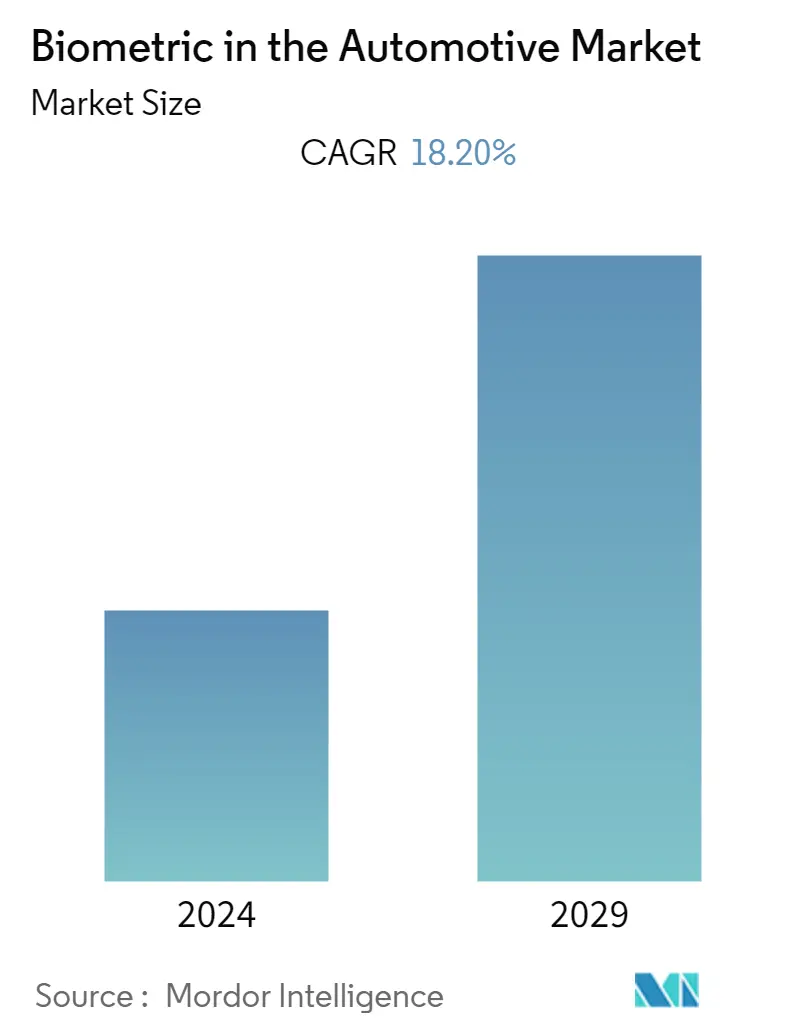Market Size of Biometric in the Automotive Industry

| Study Period | 2019 - 2029 |
| Base Year For Estimation | 2023 |
| CAGR | 18.20 % |
| Fastest Growing Market | Asia Pacific |
| Largest Market | North America |
| Market Concentration | Medium |
Major Players
*Disclaimer: Major Players sorted in no particular order |
Biometric in the Automotive Market Analysis
The global biometric in the automotive market is expected to register a CAGR of 18.2% during the forecast period. After the increased adoption of biometrics in electronic devices, the applications of biometrics in automotive vehicles have also been gaining traction in recent years. Yet the implementation of this technology has been limited to the premium vehicle segment, but in recent years, its applications are estimated to enter the general personal vehicle segment due to its better vehicle security and other accessibility advantages.
- In the automotive industry, the application of biometrics lies in various areas, including access control for starting a vehicle using various biometric scanners, enabling personalized vehicles for the users to allow drivers and passengers to call up playlists, contacts, and preferred apps. The application of these biometrics in automotive vehicles is expected to increase during the forecast period.
- Iris recognition is considered a reliable and accurate biometric technique for authentication of the driver in automobiles, and players are approaching with more features, such as securing the multiple services offered through the gateway. In April 2022, Hyundai filed a patent for a system that uses iris scanning technology to verify the driver's identity when they get into the vehicle. This system also prevents someone from starting the vehicle unless there is a biometric match.
- Recently, EyeLock announced a collaboration to apply its iris biometric authentication technology to the SiriusXM e-Wallet in a highly secure, touchless gateway prototype. Drivers and passengers will be able to find, pay, or pre-pay for coffee, gas, movie tickets, or parking while on the go. It helps to eliminate driver distractions during transaction processes, capturing driver or passenger iris biometrics with EyeLock's custom-designed, visor-mounted prototype. Such new technology caters to a new future trend in the biometric application in the iris recognition segment.
- Facial recognition has been gaining importance in the automotive sector. Automaker Subaru introduced facial recognition into its latest Forrester model. The system combines an infrared LED and a camera to monitor the driver for signs of inattention or sleepiness, warning them if needed. The system recognizes up to five individual drivers, so settings and preferences can be automatically adjusted for each person.
- Furthermore, various automobile players have also implemented fingerprint technology to unlock their cars. Fingerprint identification is majorly accepted in biometric identification as the probability of finding two same fingerprints is one in 64 billion, even with twins, increasing its credibility.
- Automobile players, such as Hyundai Motor, use fingerprints where multiple drivers can register theirs. Depending on the fingerprint, the car will automatically adjust seat positions and the angle of the rearview mirrors. Hyundai says its method to add fingerprint technology uses the human's capacitance where the reader differentiates and prevents hacking or any forged fingerprints. It has been said that the reader has an error rate of 1 in 50,000.
- Due to the COVID-19 pandemic, the production unit of automotive has fallen steeply at the global level. According to the European Automobile Manufacturers Association, EU-wide production losses due to factory shutdowns amount to at least 2,446,344 motor vehicles so far. In particular, biometric systems have been brought into the spotlight as a key technology for early detection, patient screening, and public safety monitoring in an effort to contain the spread of COVID-19; however, in the automobile sector, the demand reduced drastically due to low production of automotive and disruptions in the supply chain.
Biometric in the Automotive Industry Segmentation
The biometric technology system is based on behavioral and psychological characteristics used for verification and recognition of manual access. It is a user-friendly, reliable, and convenient identification and monitoring method. Biometrics across the automotive sector is utilized for identification and authentication in vehicles for a number of applications, such as for vehicular access, ignition switch, vehicle immobilizer, rationalization, and health monitoring. As per the scope of the market, biometric application in automobiles is accessed through the help of fingerprint scanner, facial recognition, voice recognition, iris recognition, and palm recognition. Further, the study includes the impact of COVID-19 on the market.
| Type | |
| Hardware | |
| Software |
| Scanner Type | |
| Fingerprint Recognition | |
| Iris Recognition | |
| Palm Recognition | |
| Facial Recognition | |
| Voice Recognition | |
| Others Scanner Types |
| Geography | |
| North America | |
| Europe | |
| Asia-Pacific | |
| Latin America | |
| Middle East and Africa |
Biometric in the Automotive Market Size Summary
The automotive biometric market is experiencing significant growth, driven by the increasing integration of biometric technologies in vehicles. Initially limited to premium vehicles, these technologies are now expanding into the general personal vehicle segment, offering enhanced security and accessibility features. Biometric applications in the automotive sector include access control through biometric scanners, personalized vehicle settings, and advanced safety measures. Technologies such as iris recognition, facial recognition, and fingerprint identification are gaining traction, with companies like Hyundai, Subaru, and Tesla leading the way in implementing these innovations. The focus on facial recognition is particularly notable, as it not only enhances vehicle security but also offers personalized user experiences by adjusting vehicle settings based on driver preferences and behaviors.
The market is characterized by moderate competition, with major players and new entrants expanding their presence through strategic partnerships and technological advancements. North America stands out as a key region for biometric applications in the automotive industry, with companies like Ford and BMW exploring these technologies to differentiate their offerings. Recent developments include collaborations aimed at enhancing vehicle safety and enabling secure digital transactions from vehicles. As the demand for motor vehicles rises, the adoption of biometric technologies is expected to increase, driven by the need for improved security, convenience, and personalized experiences in the automotive sector.
Biometric in the Automotive Market Size - Table of Contents
-
1. MARKET DYNAMICS
-
1.1 Market Overview
-
1.2 Industry Attractiveness - Porter's Five Force Analysis
-
1.2.1 Bargaining Power of Buyers
-
1.2.2 Bargaining Power of Suppliers
-
1.2.3 Threat of New Entrants
-
1.2.4 Threat of Substitute Products
-
1.2.5 Intensity of Competitive Rivalry
-
-
1.3 Industry Value Chain Analysis
-
1.4 Market Drivers
-
1.4.1 Increase in Need for Safety and Security System Across the Emerging Markets of Automobile Sector
-
1.4.2 Benefits From Insurance Companies for Vehicles Installed with Biometric Technology
-
-
1.5 Market Restraints
-
1.5.1 Lack of Standardization
-
-
1.6 Assessment of Impact of COVID-19 on the Market
-
-
2. MARKET SEGMENTATION
-
2.1 Type
-
2.1.1 Hardware
-
2.1.2 Software
-
-
2.2 Scanner Type
-
2.2.1 Fingerprint Recognition
-
2.2.2 Iris Recognition
-
2.2.3 Palm Recognition
-
2.2.4 Facial Recognition
-
2.2.5 Voice Recognition
-
2.2.6 Others Scanner Types
-
-
2.3 Geography
-
2.3.1 North America
-
2.3.2 Europe
-
2.3.3 Asia-Pacific
-
2.3.4 Latin America
-
2.3.5 Middle East and Africa
-
-
Biometric in the Automotive Market Size FAQs
What is the current Biometric in the Automotive Market size?
The Biometric in the Automotive Market is projected to register a CAGR of 18.20% during the forecast period (2024-2029)
Who are the key players in Biometric in the Automotive Market?
Synaptics Incorporated, Fingerprint Cards AB, Continental AG, Aware Inc. and Shenzhen Goodix Technology Co. Ltd are the major companies operating in the Biometric in the Automotive Market.

